02.11.11
Posted in Winter Weather at 8:00 am by Rebekah
Four years ago, a massive winter storm struck the midwestern and northeastern U.S. and southeastern Canada, peaking in intensity on Valentine’s Day.

NASA image of snow cover over the Midwest
On February 10th, a low pressure system developed on the east side of the Rockies and began to move across the Great Plains. The low strengthened as it moved eastward, and reached the mid-Atlantic coast by the 14th, at which point it moved northward up the coast.
Cold, arctic air plunged southward in the wake of the low, as a high pressure system moved from Canada into the Northern Plains.

NWS surface weather map
Throughout the storm’s life, over 6 inches of snow fell in a swath from the Midwest to the Northeast and up into southeastern Canada. The Northeast also experienced blizzard conditions after the low passed and up to 2 feet of snow in places. Areas east of Lake Ontario and Lake Erie received some record amounts of lake-effect snow. Heavy sleet and freezing rain also fell from the lower Ohio Valley to the mid-Atlantic and New England. In the Southeast, severe thunderstorms and tornadoes were reported.

The National Weather Service claimed this winter storm was one of the three largest snow storms to affect the Northeast since 1940.
For more on the Valentine’s Day Storm, see Wikipedia, NWS State College, NWS Burlington, and NOAA News.
Permalink
02.10.11
Posted in Weather News, Winter Weather at 12:16 pm by Rebekah
Daily record lows are broken all the time. But it isn’t every day that the all-time record low for an entire state is broken.
Early this morning the temperature dropped to –28 °F in Bartlesville, in northeast Oklahoma. That’s 28 BELOW ZERO. This broke the previous all-time record low for Oklahoma, -27 °F, set in 1905 and tied in 1930. Note: this value is “unofficial”, meaning it will have to go through review for it to become an official low.
The recent heavy snowfall in northern Oklahoma helped in this case, as temperatures will drop more when there is a heavier snowpack.
Based on the Oklahoma Mesonet, the temperature got even lower than this, though, as Nowata, Oklahoma (near Bartlesville) reached -31 °F this morning. However, as this was not a standard recording station set up by the NWS or FAA, the temperature will likely remain unofficial.

Oklahoma Mesonet, showing the lowest recorded temperatures since midnight.
Oklahoma City dropped to -5 °F, a new record low for February 10th for the city (plus Oklahoma City hadn’t dropped below zero since February 1996), and Tulsa dropped to -12 °F last night, tied for 5th lowest and the coldest since 1930.
Other record lows for the 10th include Springfield, Missouri (-10 °F), Wichita, Kansas (-17 °F), Amarillo, Texas (-6 °F), Dallas, Texas (15 °F), and Austin, Texas (19 °F).
Relief is on the way, though…temperatures could hit 70 °F here in central Oklahoma on Sunday! 🙂
Permalink
02.09.11
Posted in Winter Weather at 8:00 am by Rebekah
Last week the University of Oklahoma (OU) shut down for a whopping FOUR days in a row, which was unprecedented. Today, schools and universities are closed again, for the second significant snow storm within a week.
Question: how long will OU close this week? Depending on how much snow we get, schools may be closed again tomorrow and possibly even Friday. I’m not taking any classes and I can do most of my research work from home, so it doesn’t really matter to me…but some students have barely had any class since the semester started.
An article in the OU school newspaper on Monday quoted the Vice President and Provost as saying “The faculty is asked to make up that lost time in the remainder of the class period. They should cover the same material without scheduling additional classes.”
Here’s the article from the OU Daily: No make-up classes allowed after days off
I have had a few professors, all for OU graduate classes (not just in meteorology), who have scheduled make-up classes when they have to cancel class because of conferences or snow or something. Part of the problem is when not everyone can come…students should not be expected to know material that is taught outside of normal class hours (unless perhaps it’s something from the book, if there is a book). I have an idea that some of these professors will still be scheduling make-up classes, in spite of the Provost.
What do you think about that? Should professors be allowed to schedule make-up classes?
Permalink
02.03.11
Posted in Weather News, Winter Weather at 8:00 am by Rebekah

The big snowstorm of the last few days is pretty much over for the U.S. and Canada. The highest storm total report I heard was 26.5 inches of snow just west of Racine, Wisconsin.
Following is a graphical summary of snow reports from the storm. Many of the NWS forecast offices have more information about the storm in their area; click on the desired link to get to that forecast office’s web page.
Note: all of these images may be enlarged by clicking on them, including the above image from NOAA, showing the storm on the 1st.
National, 24-hr snowfall ending 8 am Central Time on Feb. 2nd, from the NWS Experimental Snowfall Analysis (some of the below NWS offices just zoomed in on this map for their regional snow maps):

NWS Norman, Oklahoma:
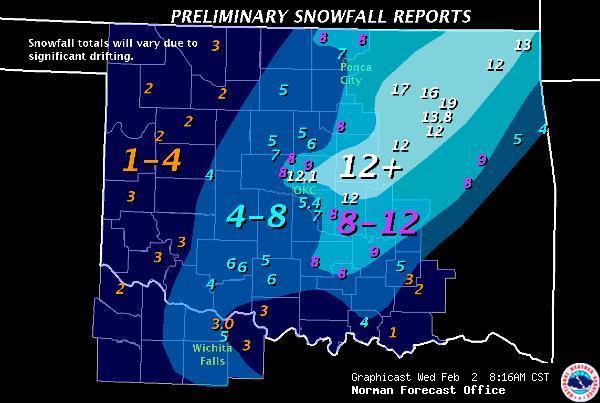
NWS Tulsa, Oklahoma:

NWS Wichita, Kansas:

NWS Topeka, Kansas:
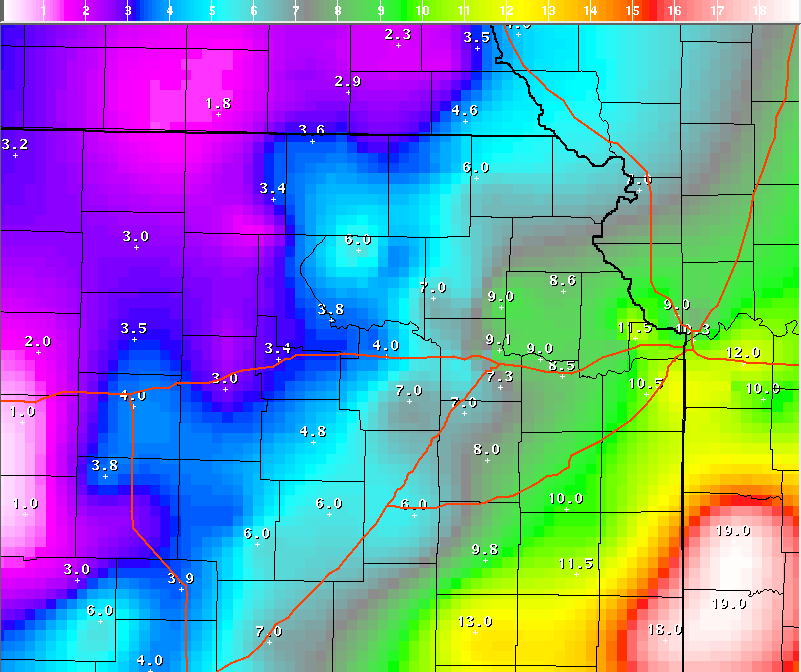
NWS Springfield, Missouri:

NWS Kansas City/Pleasant Hill, Missouri:

NWS St. Louis, Missouri:

NWS Hastings, Nebraska:

NWS Omaha/Valley, Nebraska:

NWS Des Moines, Iowa:

NWS Sioux Falls, South Dakota:

NWS Quad Cities, Iowa/Illinois:

NWS Lincoln, Illinois:
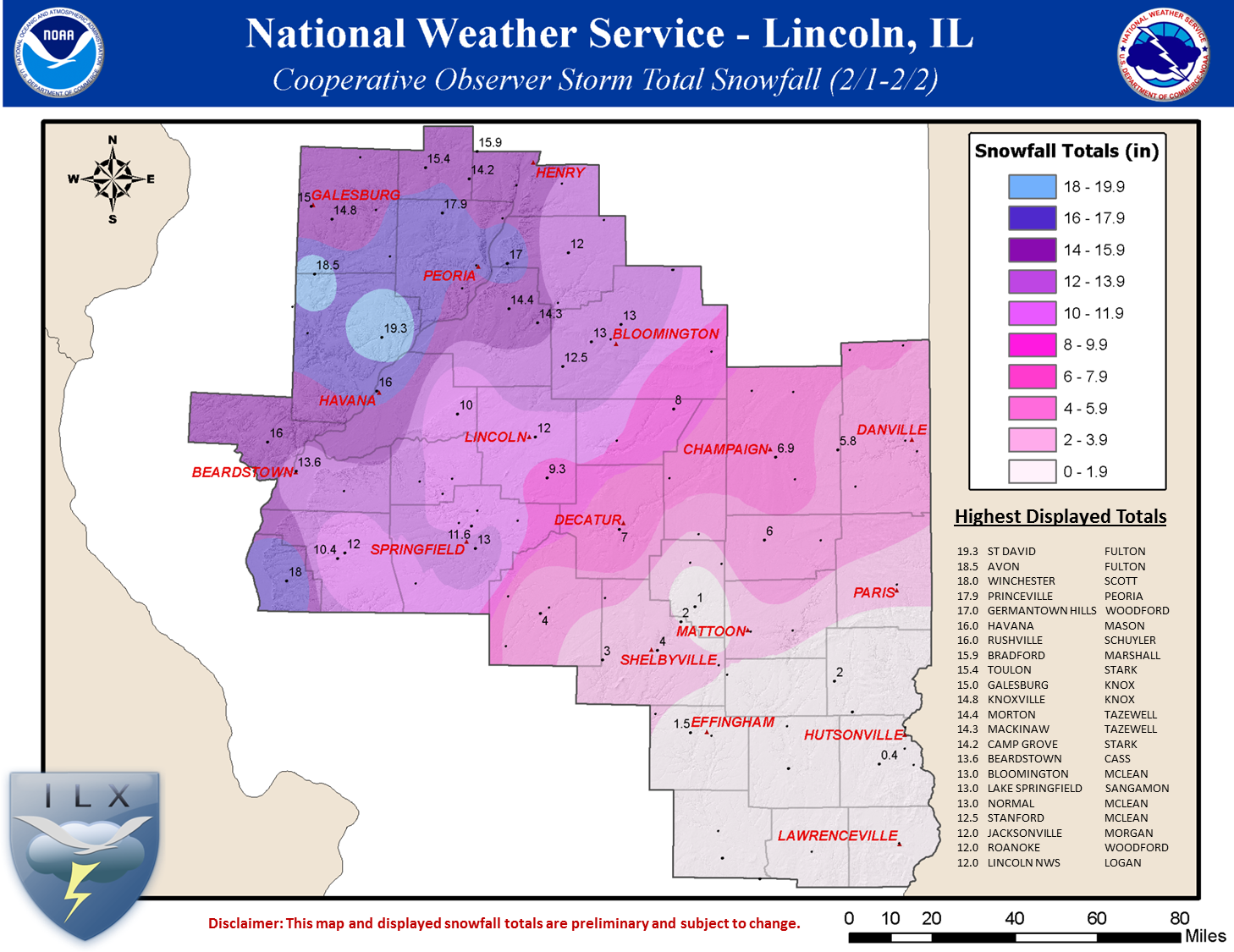
NWS Chicago, Illinois:

NWS Northern Indiana:
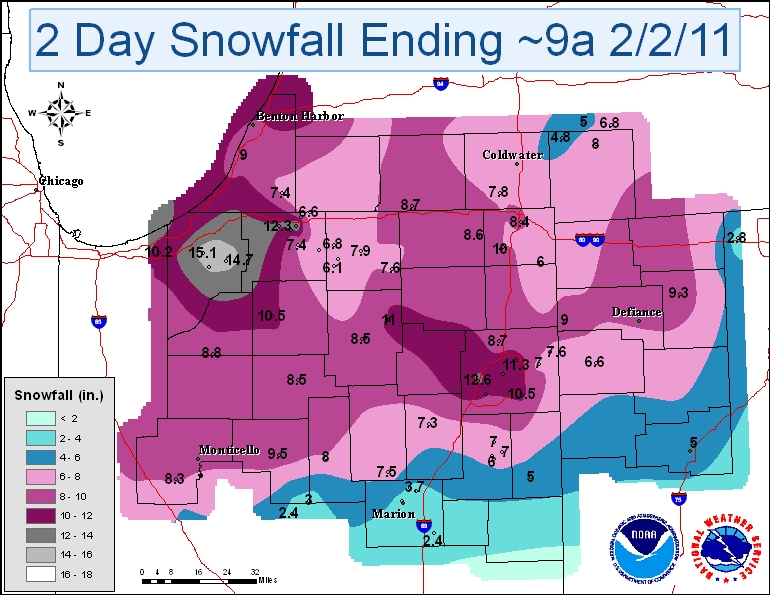
NWS La Crosse, Wisconsin:
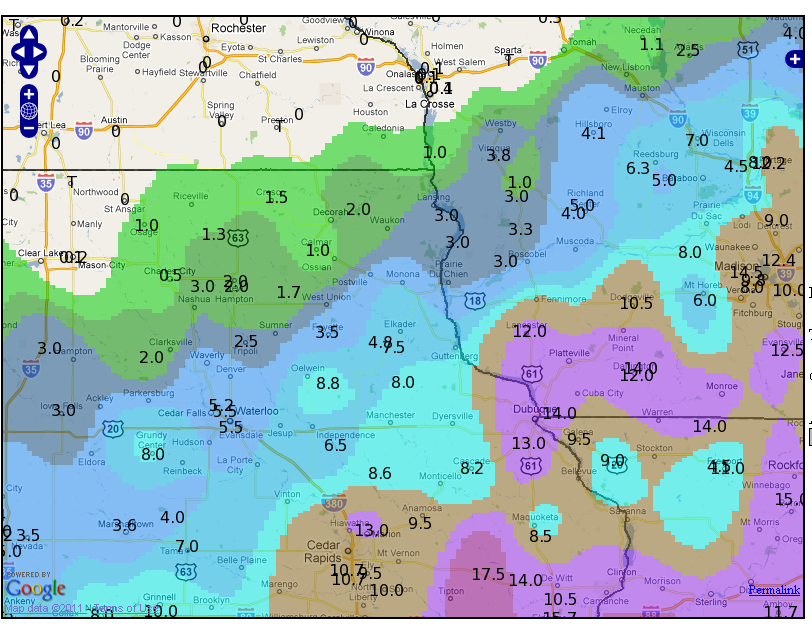
NWS Milwaukee, Wisconsin:

NWS Grand Rapids, Michigan (this write-up opens as a PDF):
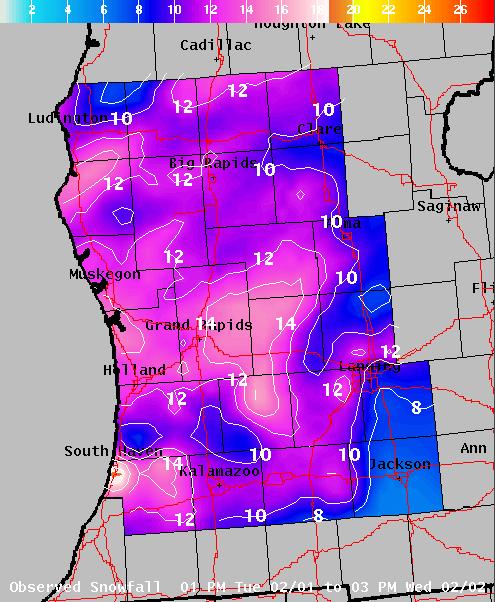
NWS Detroit, Michigan:

To see a text list of snow totals across the U.S., see the Hydrometeorological Prediction Center’s Storm Summary.
http://www.srh.noaa.gov/oun/enhanced.php
Permalink
02.02.11
Posted in Winter Weather at 8:00 am by Rebekah
Snowmageddon. Snowpocalypse. The Storm of the Century.
It seems like just about every snowstorm in the past year or so has been described in epic proportions, provided that it 1) has affected more than a couple of states, 2) has produced at least a few inches of snow, and 3) has occurred east of the Mississippi.
While some aspects of these storms may have been unprecedented in one way or another, I do not believe that such words should be used to describe every storm.

If we call every snowstorm “epic”, or always use such words to describe a storm, we lose some credibility and may not be able to adequately convey when a storm really is “epic”.
Any snowstorm can be dangerous and life-threatening, and snowstorms happen every year. Blizzards resulting in several foot snow drifts happen every year (granted, not always in highly-populated areas, but they do happen). If we hype up every ordinary snowstorm, some people may eventually stop paying attention to warnings when they need to.
They may say “oh, I made it through that one snowpocalypse just fine, so why should I prepare or stay home for this one?” This is part of why the media then proceeds to take up using even grander terms, to describe another blizzard that was not much different from the last one.
Then when a storm sets up that could truly be called “the storm of the century”, we may not be left with great enough words to describe it in a way that people will heed warnings, prepare, and stay home.
The National Weather Service and the media has used some pretty strong words to warn people of this recent/ongoing winter storm from Dallas to Boston. The National Weather Service in Norman (as well as some of the media outlets) claimed that the blizzard could produce similar results in Oklahoma to those from the Christmas Eve ’09 blizzard.
How did people react to these warnings?
While many people participated in panic buying over the weekend, hundreds of people became stuck on roads in northeastern Oklahoma on Tuesday. Why did the people who were out and about in the snow not stay home? The Christmas Eve ’09 blizzard left hundreds of cars stuck in the snow as well, and it was recent enough to where it should have easily been remembered. Did they not believe the warnings? Did they think that they were invincible? On a side note, what was so important that they “had” to be on the roads…schools were all closed and many, if not most, businesses were shut down as well…there seemed to be an awful lot of non-essential travel going on.
Whatever the reason for people driving in the blizzard, I somehow doubt that there would have been fewer people on the roads had this storm been called the storm of the millennium.
Chuck Doswell recently posted on a similar subject in his blog: “How much warning of danger is too much?”
Now, I’m interested to know, what do YOU think about the use of terms such as “snowpocalypse” and “snowmageddon”?
Permalink
« Previous Page — « Previous entries « Previous Page · Next Page » Next entries » — Next Page »

























